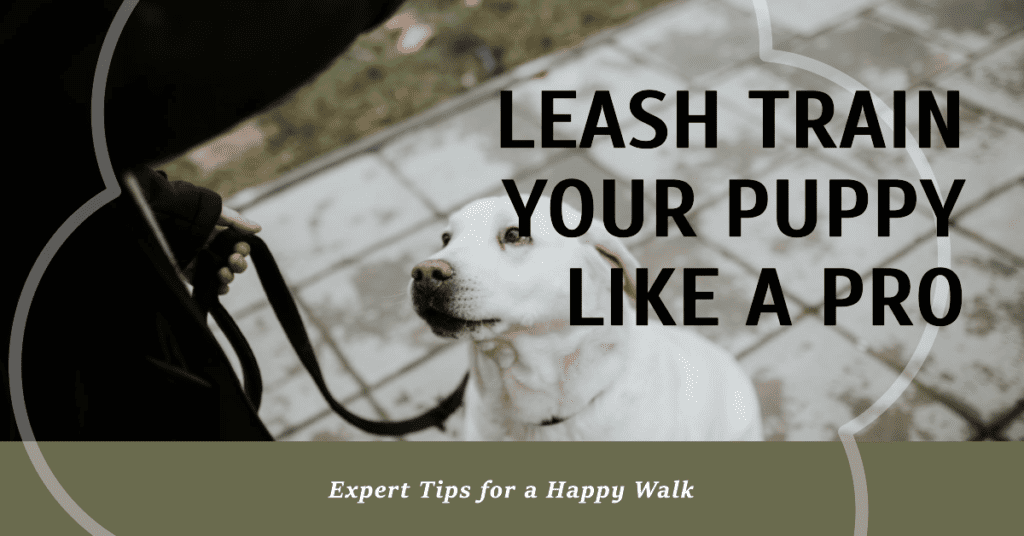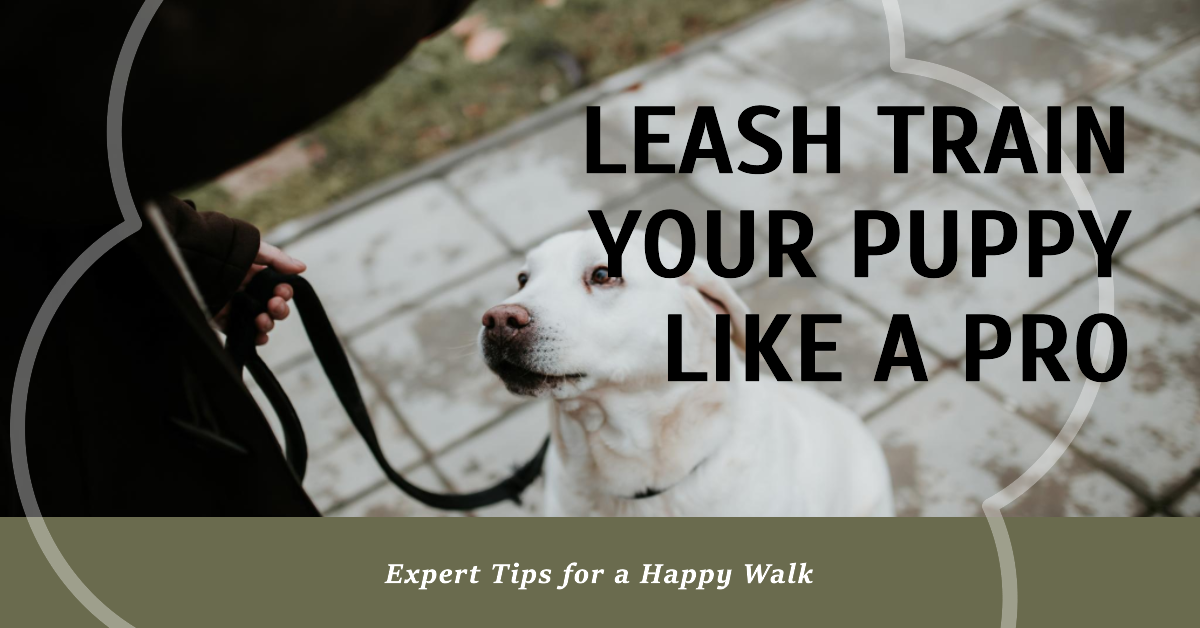So you recently brought home a new furry addition to your family- a cute little puppy. While the antics and playfulness of your new furball bring joy to your heart, the time has come to teach them proper leash etiquette. Leash training is an essential skill that every puppy should learn, not only for their safety but also for yours. In this article, we will guide you through the process of leash training a puppy, providing you with expert tips and techniques to ensure a successful and enjoyable experience for both you and your furry friend.
So lets dive in How To Leash Train A Puppy
How To Leash Train A Puppy
Leash training is an essential skill for any puppy, as it allows them to safely explore the world while remaining under your control. Before you begin leash training, there are a few important steps to take to ensure success.
Choosing the Right Leash and Collar
The first step in preparing for leash training is selecting the right leash and collar for your puppy. A leash that is too long or too short can make it difficult to maintain control, while a collar that is too loose or too tight can be uncomfortable for your furry friend. Opt for a sturdy leash that is approximately six feet long and a collar that fits securely without causing any discomfort.
Getting the Proper Identification
Before venturing outside for leash training, it is crucial to ensure that your puppy has proper identification. Attach a durable and legible ID tag to your puppy's collar, containing their name, your contact information, and any other relevant details. Additionally, consider microchipping your puppy as an extra layer of protection in case they ever become lost.
Making the Environment Familiar
Leash training can be a bit overwhelming for a young puppy, so it is important to make the training environment as familiar and comfortable as possible. Start the training sessions in a quiet and familiar space, such as your backyard or a quiet park. Minimize distractions and gradually introduce new environments as your puppy becomes more comfortable and confident on the leash.
Introducing the Puppy to Collar and Leash
Before you can start leash training, your puppy needs to become familiar with wearing a collar and being attached to a leash. Begin by introducing your puppy to the collar, allowing them to sniff and explore it at their own pace. Once they are comfortable with the collar, attach a lightweight and non-restrictive leash and let them drag it around under your supervision. This will help your puppy get comfortable with the sensation of being leashed before you begin formal training.
Basic Commands for Leash Training


Once your puppy is comfortable wearing a collar and being on a leash, it is time to start teaching them some basic commands that will make leash training easier and safer.
Teaching the ‘Sit' Command
The ‘sit' command is a fundamental command in leash training, as it helps your puppy learn how to be still and controlled on the leash. To teach your puppy to sit, hold a treat close to their nose and slowly move it upward, causing their bottom to lower naturally. As their bottom touches the ground, say “sit” and reward them with the treat. Repeat this process consistently until your puppy understands and reliably responds to the command.
Teaching the ‘Stay' Command
The ‘stay' command is crucial during leash training as it helps ensure your puppy remains in a designated spot when necessary. Begin by asking your puppy to sit, then hold your hand up in a stop sign position while saying “stay” in a firm and calm voice. Take a small step back, and if your puppy remains in place, immediately return to them and reward with a treat and praise. Gradually increase the distance and duration of the ‘stay' command as your puppy becomes more proficient.
Teaching the ‘Come' Command
The ‘come' command is essential for teaching your puppy to come towards you when called, especially during off-leash walks or in emergency situations. Start by kneeling down, open your arms, and enthusiastically say “come.” Using an excited and cheerful tone, encourage your puppy to come towards you. When they reach you, reward them with a treat and plenty of praise. Practice this command in a controlled environment before trying it in more distracting situations.
Building Positive Associations
To make leash training a positive and enjoyable experience for your puppy, it is crucial to build positive associations with the leash and training process.
Using Positive Reinforcement
Positive reinforcement is a powerful tool in leash training. Whenever your puppy exhibits desired behavior, such as walking calmly on the leash or responding to commands, reward them immediately with treats, affection, and verbal praise. This positive reinforcement helps your puppy associate good behavior with pleasant rewards, making them more likely to repeat it in the future.
Rewarding with Treats and Praise
Treats and praise are two effective ways to reward your puppy during leash training. Use small, bite-sized treats that are highly enticing to your puppy. Along with treats, lavish your puppy with praise in an enthusiastic and happy tone of voice. Verbal praise, such as “good job” or “well done,” helps reinforce positive behavior and strengthens the bond between you and your furry companion.
Playing Fun Training Games
Leash training doesn't have to be all serious and formal. Incorporate fun training games into your sessions to make them more engaging and enjoyable for your puppy. For example, you can play a game of hide and seek, where you hide around the corner and call your puppy to come to find you on the leash. These interactive games not only improve leash skills but also provide mental stimulation and strengthen the bond between you and your puppy.
Establishing Walking Routines
Establishing a consistent walking routine is key to successful leash training. By following a structured routine, you can ensure your puppy gets the exercise they need while reinforcing good leash manners.
Start with Short and Enclosed Walks
When you first start leash training, begin with short and enclosed walks in a familiar and safe environment. This could be your backyard or a quiet park with minimal distractions. Short walks help your puppy get used to the sensation of being on a leash without overwhelming them. Gradually increase the length and complexity of the walks as your puppy becomes more comfortable and confident.
Gradually Increase Distance and Duration
As your puppy becomes more adept at walking on a leash, gradually increase the distance and duration of your walks. Begin by adding a few minutes to each walk, and over time, work up to longer walks. This gradual increase allows your puppy to build endurance and strengthen their leash skills gradually. It is important to remember not to push your puppy too hard, as overexertion can lead to fatigue and discourage their progress.
Choosing the Right Walking Route
When selecting a walking route, consider your puppy's needs and preferences. Opt for routes that offer a variety of sights, sounds, and smells, as this can provide valuable mental stimulation for your puppy. However, be mindful of overly crowded or noisy areas that may cause anxiety or distraction. Choose routes that are well-maintained and safe, avoiding areas with heavy traffic or potential hazards.
Maintaining Consistency in Walk Times
Consistency is key when establishing walking routines. Try to maintain a consistent schedule for your walks, taking your puppy out at the same times each day. A routine helps your puppy anticipate their walks, making them more cooperative and focused on the training. Additionally, consistent walk times contribute to regulating your puppy's bathroom habits, as they will learn to associate the walks with toilet breaks.
Dealing with Common Challenges
Leash training may present a variety of challenges along the way. Here are some strategies to help address common issues that may arise during training.
Leash Pulling and Lunging
If your puppy tends to pull or lunge on the leash, it is essential to address this behavior early on. Start by giving your puppy a short, quick tug on the leash whenever they begin to pull. Immediately reward them with praise and treats as soon as they return to your side. Consistency is key in addressing leash pulling, so be sure to repeat this process consistently until your puppy learns to walk calmly beside you.
Chewing and Biting the Leash
Some puppies may find the leash irresistible and attempt to chew or bite it. To discourage this behavior, redirect your puppy's attention whenever they start chewing or biting the leash. Offer them a chew toy or treat that they can bite instead, and praise them for choosing the appropriate object. With consistent redirection and positive reinforcement, your puppy will gradually learn that the leash is not something to be chewed or bitten.
Reacting to Distractions
Puppies are naturally curious and easily distracted, especially when exploring new environments on a leash. To manage their reactions to distractions, use the ‘leave it' command. Whenever your puppy shows interest in something that you want them to ignore, say “leave it” in a firm and confident tone. Redirect their attention towards you with a treat or a toy, rewarding them for complying with the command. With practice, your puppy will learn to ignore distractions and remain focused on you during walks.
Fear or Anxiety on Walks
Some puppies may experience fear or anxiety during leash training, particularly when exposed to new or unfamiliar environments. If your puppy shows signs of fear or stress, such as cowering, trembling, or excessive panting, it is crucial to approach these situations with patience and understanding. Take things slow, gradually introducing your puppy to new environments and providing plenty of positive reinforcement and reassurance. If the fear or anxiety persists, consult with a professional trainer or behaviorist for further guidance.
Socialization and Leash Training
Leash training provides an excellent opportunity to socialize your puppy and expose them to different people, animals, and environments.
Introducing the Puppy to New Environments
Socializing your puppy with new environments is an important aspect of leash training. Gradually introduce your puppy to new places and situations, such as parks, streets, and other dog-friendly areas. Start with less stimulating environments and gradually progress to busier and more crowded places. Allow your puppy to explore at their own pace, providing positive reinforcement and reassurance along the way.
Exposing to Different People and Animals
During leash training, it is crucial to expose your puppy to various people and animals. Introduce them to friends, family members, and neighbors, ensuring positive experiences with each interaction. Encourage gentle and calm interactions, rewarding your puppy for exhibiting amicable behavior. Additionally, seek out opportunities for your puppy to socialize with other dogs, either through scheduled playdates or controlled interactions at a local dog park.
Teaching Proper Behavior on Leash
As part of socialization, it is essential to teach your puppy proper behavior on the leash when encountering other people and animals. Teach your puppy to approach others calmly and politely, avoiding jumping, barking, or any other unwanted behavior. Reward your puppy for exhibiting good manners and reinforce positive behavior during leash encounters. Consistent training and positive reinforcement will help your puppy become a well-behaved and sociable companion.
Advanced Leash Training Techniques
Once your puppy has mastered the basics of leash training, you can move on to more advanced techniques that enhance their skills and control on the leash.
Walking Off-Leash in Controlled Areas
With sufficient training and practice, you may choose to allow your puppy off-leash in controlled areas. Start by finding an enclosed space, such as a fenced backyard or a designated off-leash area. Practice recall commands, such as “come” and “stay,” in a safe and secure environment. Gradually increase the level of distractions and practice in various locations, ensuring that your puppy responds reliably to your commands.
Heel Training
Heel training refers to teaching your puppy to walk calmly and closely beside you without pulling or lagging behind. To teach your puppy to heel, start by holding a treat at your side, and encourage them to walk beside you, focusing on the treat. Reward your puppy with treats and praise for maintaining the proper position. Gradually decrease the frequency of treats and focus more on verbal praise to reinforce the desired behavior. Consistent practice and reinforcement will help your puppy master the heel command.
Teaching ‘Leave It' and ‘Drop It' Commands
The ‘leave it' and ‘drop it' commands are invaluable during leash training, as they help prevent your puppy from picking up harmful objects or engaging in unwanted behaviors. To teach the ‘leave it' command, hold a treat in your hand and close your fist. Allow your puppy to sniff and paw at your hand, but only reward them when they back away or lose interest in the treat. Similarly, to teach the ‘drop it' command, offer your puppy a toy or object and say “drop it” as you offer a treat. Reward your puppy when they release the item. Consistent practice will help your puppy learn to obey these commands reliably.
Safety Measures During Leash Training
While leash training is meant to cultivate a positive and enjoyable experience, it is essential to prioritize your puppy's safety and well-being throughout the process.
Avoiding Excessive Force or Punishment
Never resort to excessive force or punishment during leash training. This can cause your puppy to become fearful or anxious, hindering their progress and potentially damaging your bond. Instead, focus on positive reinforcement and reward-based training methods. Use firm and consistent cues, paired with treats and praise, to encourage desired behaviors. Patience, understanding, and encouragement will yield far better results than punishment or force.
Using Leash Attachments Properly
Properly attaching the leash to your puppy's collar or harness is crucial for their safety and security. Ensure that the leash is securely fastened to prevent accidental escapes or injuries. Avoid using retractable leashes during leash training, as they can make it difficult to maintain control and potentially lead to accidents. Regularly inspect the leash and collar for any signs of wear and tear, replacing them as necessary to prevent accidents or breakages.
Maintaining Proper Hygiene and Health
Maintaining proper hygiene and health is essential during leash training. Regularly check your puppy's paws for any signs of irritation, ticks, or injuries. Clean their paws after walks to prevent dirt or debris from causing discomfort. Practice good hygiene by washing your hands thoroughly after handling the leash, as it can become dirty and carry bacteria. Additionally, keep your puppy up to date on vaccinations and flea/tick prevention to ensure their overall health and well-being.
Watching for Signs of Discomfort or Stress
During leash training, it is crucial to keep a close eye on your puppy's body language and behavior for any signs of discomfort or stress. If your puppy displays excessive panting, whining, cowering, or tries to escape from the leash, it may indicate that they are feeling overwhelmed or anxious. Immediately stop the training session, provide reassurance, and evaluate the situation to identify potential triggers. If the issue persists or worsens, seek guidance from a professional trainer or behaviorist.
Consulting a Professional Trainer
While leash training can be a rewarding experience, sometimes it may be beneficial to seek the guidance of a professional trainer to address specific challenges or further enhance your training techniques.
Benefits of Professional Guidance
A professional trainer brings expertise and experience to provide personalized guidance tailored to your puppy's needs. They can help address specific issues, refine training methods, and offer advice on handling more complex situations. A trainer can also provide valuable insights into canine behavior and communication, facilitating a deeper understanding of your puppy's needs.
Finding a Qualified and Experienced Trainer
When searching for a professional trainer, look for someone who is qualified, experienced, and uses positive reinforcement methods. Seek recommendations from trusted sources, such as veterinarians, friends, or online reviews. Interview potential trainers to ensure they align with your training philosophy and have a proven track record of successful training outcomes.
Understanding Training Techniques and Philosophy
Before working with a professional trainer, take the time to familiarize yourself with their training techniques and philosophy. It is essential to ensure that their methods align with your values and goals for your puppy's training. Open communication with the trainer is crucial to establish a strong partnership and achieve the desired results.
Consistency and Patience in Training
Consistency and patience are key ingredients in successful leash training. Here are some important considerations to keep in mind throughout the training process.
Set Realistic Expectations
Leash training is a gradual process that takes time, so it's important to set realistic expectations. Each puppy progresses at their own pace, so be patient and understand that there may be setbacks along the way. Celebrate every small achievement and focus on the progress your puppy is making rather than focusing solely on the end goal.
Staying Consistent with Training Methods
Consistency is critical when training your puppy. Use the same cues, rewards, and techniques consistently to reinforce desired behaviors. Inconsistency can confuse your puppy and hinder their progress. Ensure that all family members involved in the training process are on the same page and follow the same training methods to avoid confusion.
Being Patient and Understanding
Leash training can sometimes be challenging, but it is important to remain patient and understanding throughout the process. Remember that your puppy is learning and adapting to a new skill, and they may need time to fully grasp it. Stay calm and composed, providing reassurance and support to your puppy as they navigate through the training journey.
Leash training is a vital aspect of raising a well-behaved and obedient puppy. By following the steps outlined in this comprehensive guide, you can set your puppy up for success and establish a strong bond built on trust and positive reinforcement. Remember to be patient, consistent, and understanding, and soon you and your furry companion will be enjoying peaceful and enjoyable walks together.





